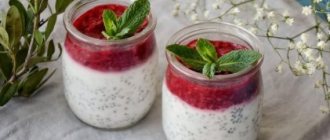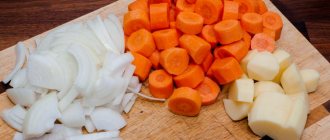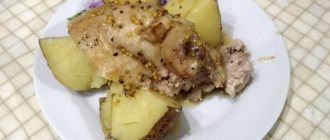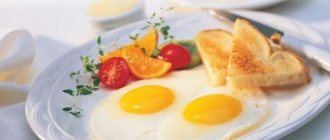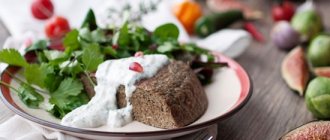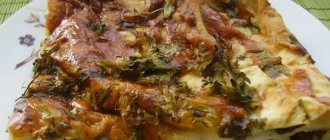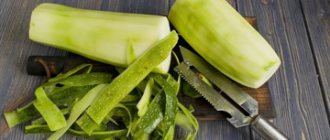Dinner should account for no more than 20% of the daily diet. With children the situation is more complicated: their day is so busy that it is difficult to calm down in the evening, they sleep poorly. At night, children wake up to have a snack (drink water, kefir). Parents try to prepare a nutritious meal for their child at night, but the problem is not solved.
In this case, you need to know what nutritionists recommend eating before bed, and what is strictly prohibited.
What foods are good to give your child for dinner?
What to cook for your child for dinner is a question that worries many parents. As a rule, children do not like healthy food, preferring all sorts of harmful products that are advertised on television. Babies are very active, so in the evening they need food that will replenish the energy spent during the day.
At the same time, the food should be light, since then you need to go to bed.
Heavy foods will not allow either mother or baby to sleep peacefully, so dinner should be no later than 19.00. This will give the food time to digest. Some nutritionists recommend that children have dinner 2 hours before going to bed. Kindergarten children should have dinner 3 hours after their afternoon snack.
Children who do not attend kindergarten have dinner 2 hours before bedtime. Sometimes the baby asks to eat just before bed. In this case, you can give him a glass of fermented milk products (ryazhenka, yogurt) to drink. It is not recommended to give a lot of liquids to drink before bed, so that the baby does not wake up in the middle of the night to go to the potty.
Sometimes children can get up at night and ask for food. Scientists believe that the child confuses the feeling of hunger with thirst (which is also typical for adults). In fact, he is thirsty at night, so you can offer him a glass of water. If your child wakes up more than 4 times a night, then the problem is not hunger or thirst.
In this case, you should contact a specialist for examination.
What to cook for your child for dinner, according to experts:
- porridge;
- cottage cheese, to which you can add fruits, cheesecakes;
- pancakes and pancakes;
- eggs, omelet;
- fruits and vegetables (you can prepare stews, salads, baked apples).
It is best to serve cereals and vegetables for dinner. You can prepare various casseroles and meatballs, vegetable and fruit salads. It is useful to add boiled vegetables, fresh fruits and dried fruits (prunes, pumpkin, apples) to porridge. You can combine vegetables and cereals in one dish (for example, vegetable cabbage rolls with rice).
Cereals contain carbohydrates, vitamins and microelements necessary for full growth.
Many parents are afraid to give their children fish due to the likelihood of allergies and the presence of small bones. In this case, we can recommend sea fish. It is less allergenic and has fewer bones. Fish, like eggs, should be given 2 times a week.
Cottage cheese and eggs are very useful for dinner: these are not only light and satisfying foods, but also help strengthen tooth enamel and the skeletal system due to the calcium content, which is better absorbed in the afternoon. Dairy products are recommended for children who are not allergic to lactose.
Children 1.5-2 years old are fed 5 times a day. For dinner it is good to give cottage cheese, make puddings and casseroles from it. At this age, baby teeth appear, so calcium is simply necessary. You can give a hard-boiled egg for dinner, or add it to mashed vegetables.
It is allowed to add green peas and carrots to omelettes. Porridges at this age are prepared semi-viscous.
In the third year of life, milk teeth allow you to chew food, so it is not necessary to grind the meat into minced meat, you can cut it into small pieces. Milk sausages and sausages, and liver are also included in the diet. For dinner, it is recommended to cook fish fillet, cheesecakes, and boiled eggs.
For five-year-old children, the menu is not as strict as for kids. They can try canned food, salted and smoked foods. The diet includes complexly prepared and fried dishes: stuffed zucchini, fried fish, aspic. At this age, you can give pearl barley porridge, a cold or hot sandwich.
Vegetable oil and butter must be present in the children's menu , as they are rich in vitamins and polyunsaturated fatty acids. Butter is used for frying, vegetable oil is used for dressing salads.
Sample menu for every day
How to diversify the children's table, and also make it not only tasty, but also healthy? There is probably no woman who would not ask this question when it comes to a child. But in fact, creating a tasty and nutritious menu for a week for a toddler is not the most difficult task. But how to do this - see below.
An example of a menu (food) for a child from 1.5 to 2 years old for every day:
Monday:
- breakfast – omelet or milk rice porridge and tea;
- lunch - meat soup or broth, boiled meat and vegetables;
- afternoon snack – kefir or fermented baked milk, fruit;
- dinner - cheesecakes or cottage cheese, vegetable stew and tea.
Tuesday:
- breakfast – milk oatmeal and tea;
- lunch – borscht, baked fish, vegetable salad and compote;
- afternoon snack – yogurt or fermented baked milk, jelly and tea;
- dinner - casserole and compote.
Wednesday:
- breakfast - omelet or buckwheat porridge with butter and compote;
- lunch - cereal soup, pasta, vegetable salad and tea;
- afternoon snack – kefir and fruit;
- dinner - boiled meat, vegetable salad and tea.
Thursday:
- breakfast – pearl barley porridge with butter and tea;
- lunch - meat soup, vegetable stew and compote;
- afternoon snack – cottage cheese, fruit and tea;
- dinner - mashed potatoes, boiled vegetables and jelly.
Friday:
- breakfast - omelet, tea and cookies;
- lunch – borscht, buckwheat porridge with stewed meat, vegetable salad and compote;
- afternoon snack – kefir, cookies and fruit;
- dinner - cheesecakes, boiled vegetables and tea.
Saturday:
- breakfast - corn porridge with butter, tea and crackers;
- lunch - meat broth, vegetable stew and tea;
- afternoon snack - yogurt, cookies and fruit;
- dinner - cheese casserole, boiled vegetables and tea.
Sunday:
- breakfast – wheat porridge with butter, tea and cookies;
- lunch – borscht, pasta with vegetable salad and compote;
- afternoon snack – fermented baked milk with cookies and fruit;
- dinner - cottage cheese with a little sour cream and tea.
This type of nutrition for children aged 1.5-2 years per week is balanced. It is worth noting that some children like to drink from a bottle before bed; the baby should be gradually weaned from this habit. The most correct thing would be to offer a 2-year-old child to drink in a cup; for this, you can purchase a special sippy cup that can soften the period of adjustment.
What foods should you avoid during your evening meal?
Not all products are recommended for consumption before bed. Some are poorly digested, which disrupts the child’s sleep, while others help increase activity.
There are foods that are strictly prohibited for dinner:
- sweets: ice cream, chocolate, candy;
- pastries and bakery products;
- fatty, fried foods;
- semi-finished meat products;
- salinity and seasoned dishes.
Nutritionists have found out what to cook for a child for dinner without harming the body. Meat provokes painful drowsiness and causes stomach upset. It is not recommended to give cholesterol foods in the form of pasta or hot sandwiches.
Meat and fish dishes must be given no later than lunch; for dinner this is heavy food.
Hot seasonings are replaced with natural products: onions, garlic, lemon juice, herbs. Also, at any time of the day, children should not be given fast food or sweet carbonated drinks. There is no need to give semolina, millet or pearl barley porridge , as they are slowly digested by the child’s body.
Better buckwheat or oatmeal.
Children most often receive baked goods as an afternoon snack, so do not overload them with simple carbohydrates. It is not recommended to drink everything with strong tea; it is better to drink compote or jelly.
Wrong dinner
The wrong dinner results from indulging the grasping reflexes of a child who does not know what to do with his energy and excitability after a busy day. This is especially true for “kindergarten” children; we discussed their dinner and the causes of “nervous hunger” here:
https://www.u-mama.ru/read/article.php?id=4717
https://www.u-mama.ru/read/article.php?id=4736
In the evening, an active child just as actively seeks the attention of adults, as if afraid of not being able to make it in time. He replaces the requests “stay with me” or “calm me down” with a demand for food that is more accessible to children’s understanding. He ate the first, the third, the tenth, begged for candy, the second, and still wants to eat, more... Be sure to make sure that the child does not stuff everything into himself, especially incompatible foods. Want to eat a lot? – please, but only after breaks. I ate a plate of stew and read it. I drank yogurt, ate a banana and played. This is how we organize the evening “zhor” and help the child to competently understand his feelings.
Any child can learn one simple truth, if you don’t belittle his mental abilities in advance and don’t think “Oh my, never!” It is necessary to constantly convince the child that a hungry person will eat everything that is offered to him. Do you want to eat? - that means eat what they give you. A child demanding food often has a very specific cookie or hidden candy in mind. It kind of tests parental fortitude. The sooner you instill in your children the right attitude towards food, towards their own feelings, the sooner they will form their own food culture. Doesn't obey, runs away, throws a tantrum, cries? - anyway, repeat from time to time that a hungry person will eat what is offered, and sweet desserts and all kinds of sausages are not food for the hungry, but pampering for the well-fed. Of course, all this is not pronounced in the boring voice of an admirer of Leo Tolstoy, raising a finger over the curly head of a baby. In a positive, confident tone, carry your thought through the days and weeks - it will definitely be postponed.
Read: Sverdlovsk residents were allowed to walk and play sports on the street from May 13
Powered by Inline Related Posts
Let’s not focus on the “harmful things”; each family has its own traditions on this matter, its own problems, its own worldview. You should not give chocolate rolls, sweets, ice cream, or hot sandwiches for dinner. Children are children, we love to pamper them, and no one has the right to blame parents for this. But still, for the sake of strengthening the immune system, for the sake of resistance to viruses and bacteria, for the sake of a healthy nervous system, you should gradually and in small ways change the quality of food, especially in the evening. In the evening and at night, the body gratefully accepts and digests clean food. At night it merges with space, and it would be nice not to spoil the feeling of flight and relaxation with food that spoils metabolism and specifically kills the “building blocks” of health (vitamins, microelements) received with daily food. Choose simpler sweets, avoid fried foods, cholesterol explosions in the form of melted cheese on bread, pasta and casseroles. In the evening, the child is not given meat dishes - the meat takes 4-6 hours to digest, and it does not bring any benefit. The exception is steamed fish, as well as canned meat for baby food; they are added in some quantities to dinner at any age. And, of course, it is extremely harmful to give a child sausages, sausages and other mixtures of chemicals and salts for dinner. Charlottes, pancakes and pancakes also cannot be called the right dish for dinner, but for variety they can be eaten in small quantities.
The most important thing is do not try to feed a hungry child in the evening if he is hungry only in your imagination. If he doesn’t want to eat, he can’t sit him down at the table - make jelly, fruit juice or compote, give him a healthy drink and calm down yourself.
Evening meal options
Despite the fact that many foods are prohibited for evening feeding, you can prepare quite a variety. Food should be warm and easily digestible.
Meat or fish with side dish
Fish stewed with rice and vegetables.
Ingredients:
- 90 g of red fish;
- 1 tbsp. l. lemon juice;
- a bunch of parsley;
- 100 g frozen vegetable mixture;
- rice.
Cooking method:
- Wash the red fish with parsley, simmer, adding a small amount of olive oil and lemon juice.
- Defrost the vegetables naturally, rinse them, and simmer them in a separate pan.
- Boil rice for garnish.
- Before serving to your child, remove all fish bones.
Fish meatballs with cottage cheese
Ingredients:
- 60 g fish fillet (for example cod);
- 30 g cottage cheese;
- 160 ml milk;
- 1 egg;
- 2 tbsp. l. sour cream;
- 30 g bread;
- 15 ml olive oil.
Dinner recipes (ages: 1.5-6 years)
Risotto “Highlight”
200 g cauliflower, 2 carrots, 1 cup rice, 4 tbsp. pitted prunes, 2 tbsp. raisins, 2 tbsp. butter.
Grate the carrots, sauté in oil, add a little water, simmer for 10 minutes. Scald the cauliflower and separate into florets. Pour 2 cups of hot water over the rice, add salt and add prunes and raisins previously soaked in water. Add vegetables and simmer risotto for 40 minutes over low heat. Before serving, sprinkle with finely chopped herbs.
Carrot-apple soufflé
350 g carrots, 60 g sour cream or milk, 30 g semolina, 1 apple, ½ egg, ½ tbsp. sugar, 2 tsp. butter, salt (to taste).
Grate the peeled apple and carrots. Grind the egg yolk with sugar, beat the white into a fluffy foam. Combine the apple and carrots, add sour cream or milk, yolk with sugar, semolina, salt, carefully add the beaten egg white, mix. Place the mixture in a greased baking dish, bake in the oven or steam for 30-35 minutes.
Omelette "Africa"
600 g carrots, 400 g milk, 4 eggs, 4 tbsp. grated hard cheese, 2 tbsp. butter, 2 tbsp. flour, 2 tbsp. orange juice, salt.
Boil and grate the carrots. Beat eggs, add milk and flour, cheese and juice, add salt and combine with carrot puree. Pour the mixture into a frying pan and fry the omelette until cooked - or bake.
Broccoli and yogurt soup
125 g plain yogurt, 1 cup broccoli, 2 potatoes, 1 carrot, 1 tbsp. grated hard cheese, 1 tsp. olive oil.
Pour boiling water over the broccoli so that the water barely covers them, cook for 5 minutes over low heat. Grate the potatoes and carrots, sauté in olive oil with constant stirring. Add the sauté to the soup, cook for another 10 minutes, cool slightly. Pour yogurt into the soup, stirring constantly. You can add cheese.
Millet-curd porridge
2/3 cup milk or water, ½ cup cottage cheese, 1/3 cup millet, 2 tbsp. yogurt or sour cream, 1 tbsp. sugar, 1 tbsp. butter, salt.
Scald the millet and pour boiling milk over it. Add sugar, salt and cook the porridge, cool. Add cottage cheese, butter, yogurt to the prepared porridge, mix.
Buckwheat porridge with prunes and dried apricots
250 g buckwheat, 100 g pitted prunes, 100 g dried apricots, salt (to taste), 600 g water.
Soak prunes and dried apricots to swell, then boil them separately, chop some finely. Combine cereals and dried fruits, pour boiling water, add salt and cook until half cooked, stirring constantly. Bring the porridge to readiness in the oven.
Before serving, add melted butter to the porridge and decorate it with the remaining prunes and dried apricots.
Baby apricot puree with rice
Dried apricots – 100g, water – 375g, baby rice porridge powder – 2 tbsp. breast milk or warmed formula – 80 ml.
Combine dried apricots and water in a small saucepan and cook until soft for 20 minutes. Make apricot puree by adding water. Mix breast milk or formula with rice powder. Serve with 1 tbsp. apricot puree. Can be stored for up to 2 days in the refrigerator. Also, the puree can be frozen into cubes.
Curd pancakes
Wheat flour – 160 g, cottage cheese – 100 g, egg – 1 pc., sugar – 10 g, soda – 1/4 tsp.
Vegetable oil – 20 ml.
Beat the egg, grind with cottage cheese, add flour, sugar and soda. Mix everything thoroughly. Grease a hot frying pan with oil and bake pancakes in it.
Scrambled eggs with vegetables “Quail egg”
2 quail eggs, 1 carrot, 0.5 stalk of celery, 1 tbsp. l. vegetable oil.
Cut the carrots into small cubes and lightly fry them in oil. Add celery cut into small pieces to the carrots. Add water to the vegetables so that it slightly covers the vegetables and simmer until tender over low heat. Beat the eggs, add them to the vegetables, mix. Cover with a lid and leave for 2 minutes.
Children's salad "Coral Reef"
200g cauliflower, 1 tomato, 1 apple, one and a half cucumbers, 2 leaves of green lettuce, 2 tbsp. sour cream, salt.
We disassemble the cabbage into inflorescences, boil it in salted water, and cool. Cut a tomato, an apple and 1 cucumber into small cubes, combine them with chopped lettuce leaves. Salt the prepared salad, season it with sour cream, mix and place cauliflower on top. We cut out a crab figurine from half a cucumber and decorate our salad with it.
Curd and fish meatballs
Cod (fillet) – 60 g, cottage cheese – 30 g, milk – 160 ml, egg – 0.5 pcs., sour cream 10% – 2 tbsp. l., white bread – 30 g, vegetable oil – 15 ml, herbs, salt.
Soak the bread in milk. Grind the fish fillet in a meat grinder, mix with cottage cheese and finely chopped onion. Mix the bread with the resulting minced meat and grind it through the meat grinder again. Beat in the egg and mix. Form the meatballs, place them in a pre-greased pan and bake for 25-30 minutes. Then pour in sour cream and cook for another 3 minutes. Sprinkle with herbs.
(Source of recipes: https://ovkuse.ru/)
Fish with vegetables and rice
90 g of any red fish, stewed in lemon juice with fresh parsley, 100 g of stewed vegetable mixture with carrots and onions. Garnish: 40 g boiled rice.
Frozen vegetables in batter
Frozen vegetables: cauliflower or broccoli, green beans separately or in a mixture - whatever the child likes. We make a batter (egg, sour cream, a spoonful of flour, salt), pour it over the vegetables - or dip them in individual inflorescences, if it is cabbage. A little breadcrumbs on top and into the oven until golden brown.
Vegetable hedgehogs with a surprise
Boil various vegetables until half cooked: potatoes, carrots, cauliflower, maybe beets. Cool, grate on a coarse grater. Add egg, salt, a little semolina or corn (buckwheat) flour, form small balls. Hide a quail egg in the middle of each ball. You can roll the hedgehogs in breadcrumbs. Bake in the oven for 8-10 minutes until the vegetables are ready.
Potato cutlets with cheese
Boil 4 medium potatoes in their jackets, peel and grate. Finely chop 2 handfuls of spinach and mix with potatoes. Add 1 egg, cheese, green onions, parsley, and salt to taste to the mixture. Form cutlets, roll them in breadcrumbs and fry or bake in the oven.
In the photographs: Max (mother Emma), Egor (mother Panda™), Nastya (mother Juicy), Kostya (mother Rebeline), Anya (mother Dreamy Mermaid).
Source
Fast and tasty dishes
Quick and tasty dishes include vegetable and fruit purees. Vegetables must first be boiled and grated. Grate fresh fruits, add honey, a little sugar or season with yogurt. If your child has a hard time falling asleep, you can give him a glass of warm milk with honey, which will calm him down.
For dinner, the child should be fed simple dishes and not overfed. In addition, you should avoid drinking too much, which leads to frequent urination. Knowing what is recommended to cook in the evening and what is not advisable, you can avoid many health problems.
What can a child eat at 3 years old?
By the age of 3, the baby’s body is already quite strong, which allows him to significantly expand the baby’s menu. In addition, at 3 years old, all children are “zubat”, which also opens up new horizons for mothers in preparing various dishes.
At this age, the baby can and should eat
- all kinds of cereals and pasta;
- fresh and boiled vegetables;
- lean meat;
- dairy products and milk itself;
- eggs;
- fish;
- fruits and berries;
- flour products;
- sugar and salt.
A child can be given in limited quantities
- sweets, such as simple candies and cookies, dark chocolate;
- pickles;
- citrus;
- honey;
Drinks allowed
- water;
- fresh or specialty juices;
- weak tea;
- chicory drink (coffee substitute);
- cocoa with milk;
- compotes and jelly from fresh, dried or frozen fruits and berries.
Features of a child’s diet at 1–2 years old
Forming a child’s menu at 1–2 years old is a responsible task for caring parents. At this time, the baby's taste preferences are formed. The structure of the dish always has its own characteristics, so it is recommended to modify the food taking into account the child’s body.
Nutrition for a child from 1 year to 2 years
When preparing meals, it is advisable to remember that the child is still developing. For example, his chewing muscles are not yet strong and developed enough to bite through coarsely cut food.
The best choice would be pureed foods or dishes that contain small lumps.
It is imperative to formulate a correct diet. For example, it is best to eat at the same time so that food is absorbed in the best possible way.
It is advisable to remember that lunch usually occurs at 12 - 13 o'clock in the afternoon, so it is advisable to take this nuance into account when developing the correct diet.
Portions of food for a baby should differ from the volume of food for an adult. The maximum possible serving size is 200 grams. It is advisable to give food more often, but focusing on this amount.
If a one-year-old child continues to be breastfed or has just finished breastfeeding, you need to understand that this aspect affects the diet. Initially, breast milk remains the main source of nutrition, so complementary feeding is only an additional meal.
Interesting! New Year gifts for children, what to give.
